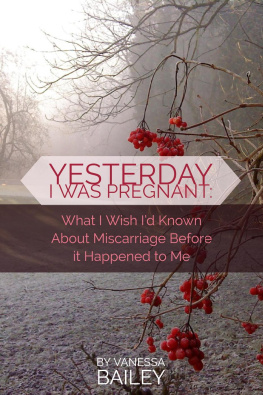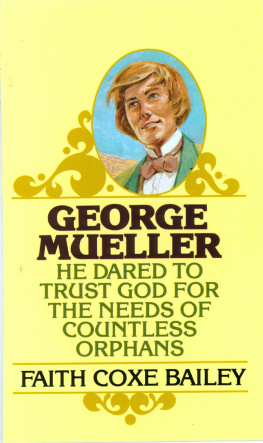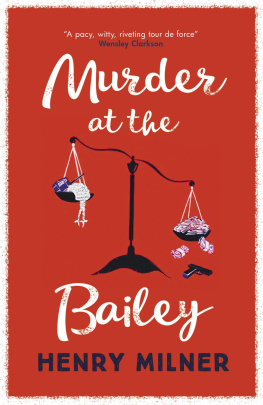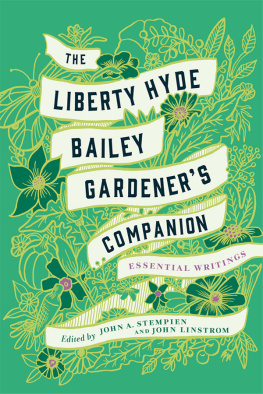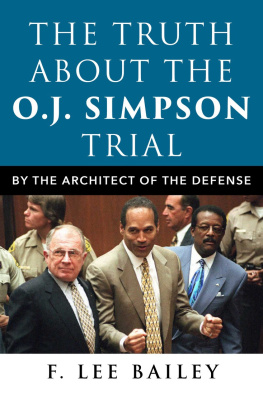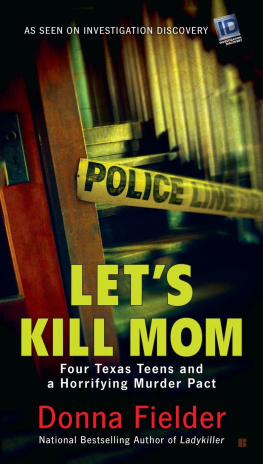T his story, as so many stories often do, began or, more properly, first took shape in the manner of a Chinese whisper, when you arent quite sure whether its repetition is an accurate account of the original telling or else just an increasingly mangled version of that initial truth.
When my father bought back Old Barn Cottage in 1966 after it had been out of the family for 23 years, I was vaguely aware of some of its dim, distant history known locally, and lip-smackingly, as The Musical Milkman Murder. But who murdered whom was the milkman the murderer or the victim? I didnt know and wasnt even particularly concerned to discover at the time.
All I think I knew then was that the killing whether by axe, shotgun, strangulation or poisoning apparently occurred a couple of years before my paternal grandfather, Lionel, had first purchased the place, then known as plain Barn Cottage (he later added the Old) for 700 as a weekend retreat from the familys North London home in 1923, before selling it in 1943 (for 1,800), at the height of the Second World War.
Our first real inkling of its infamous past came in the very early 1970s when some neighbours spotted a middle-aged woman standing outside the gate looking at the place with sad eyes. They approached her discreetly and helpfully informed her that none of the family who owned the property was currently in residence. They then enquired why she was staring so intently at the rose-covered cottage, a pretty clich of Buckinghamshire brick-and-flint, adorned with gables and criss-crossing Elizabethan timbers, dating originally from the turn of the 17th century.
She told them that, years ago, there had been a murder there. Yes, they replied, they knew of it, although they didnt have any of the real facts of the case to pass on to her. Then, to their stunned surprise and later ours when the news was relayed to my father and his family she told them that her father, the milkman, had murdered her mother Kate, and that she, Hollie, just two at the time, was their surviving child. More shockingly, Hollie probably aged about 54 as she revealed all this to our increasingly astonished neighbours then told them that shed only very recently discovered the terrible truth about her dead parents via an anonymous call.
Growing up first with her fathers sister and then with her paternal grandmother, she had always been fobbed off whenever the question of her parentage arose. All she had been told was that they had died from the fever. She remembered vividly once asking her aunt whom she was most like her father or her mother? Your father, came the chilly reply. End of conversation.
When, following the stark revelation about her parents, further elements of the truth began to filter out that Hollie had been born in the infirmary of Winchester Prison, the possibility of a botched suicide pact, and so on Hollie, by now on her third marriage and the mother of five children, as well as grandmother of increasingly more over the succeeding years, wanted finally, desperately, to nail down the real facts of the case. Her first port of call after first making contact with Births, Marriages and Deaths at Somerset House simply enough, was the location of the final resting places of her father and mother.
To Mrs Hollie D from the Governor of HM Prison, Oxford, 10 September 1973:
Dear Madam,
Thank you for your letter of 9 September. It is confirmed that a George Arthur Bailey was executed and buried at this prison. As regards your mother, I am unable to assist you. I advise you to write to the Registrar of Births and Deaths, Somerset House, London WC2 to find out the date of death and the parish in which she was buried and using this information to write to the Vicar of the parish concerned for information regarding the location of the grave.
Two days later, the Governor of Oxford Prison wrote again to Hollie in response to a note the day before asking if she could visit his grave: Thank you for your letter of 11 September I am sorry that it is not possible to allow visits to graves in the prison. I hope you are successful in tracing your mothers grave.
Whether she was pointed in the right direction by Somerset House, one doesnt know, but, on 26 September, she wrote to Buckinghamshire County Council for information and received an extremely swift response from the Superintendent Registrar referring her next to the local vicar at Little Marlow and he even enclosed a stamped, addressed envelope for the cleric to reply.
On 11 October, she received the following from Rev John Crawford, Curate of St John the Baptist, Little Marlow: Thank you for your letter. The number of your mothers grave in Little Marlow Cemetery is No 256; burial on 6 October 1920. The numbers are all lost or misplaced so it would be hard to locate but it is in the oldest part facing the chapel door. Wishing you every blessing in the future.
In November, she wrote to the Editor of the News of the World, Cyril Lear, asking if he had any back copies of the paper for 1920, the year of the murder. Her approach to the paper specifically may have been to do with the possibility that the anonymous tip-off about her parentage had originated from that now defunct Sunday newspaper. He politely replied that he couldnt help but suggested instead that she contact the Newspaper Library at Colindale, which continues to store a remarkable collection of national and regional newspapers.
The trail then ran cold, it seems, until it became apparent, in March 1974, that Hollie had made contact with my father, eight years after he bought back Old Barn Cottage; she had sent him what few bits of documentation about the case shed managed to track down. He invited her to tour the cottage properly and she sent him this letter, after her visit, on 29 March:
We were very pleased to meet you, and thank you for your kindness in letting us look over the cottage. I felt no sadness. I was three years old two days after my mother was buried. I always wanted to know where my mother was buried; as you can see, I only found out last year. My fathers mother brought me up. I was brought up to believe that it was meant to be a triple suicide, but my father lost his nerve and it was only my mother that died. I know he was hung at Oxford Prison. I excepted [sic] that. My grandmother died when I was nearly 17 years old. I was left to make my own life. When I received my mothers death certificate last year, I knew there was more than I had been told. When I wrote away to the London Library and received the papers, I was shattered. My tears were for my poor mother, only 22 years old and 7 months pregnant
Hollie then concluded her letter by also thanking my father for his offer to her of a job looking after the cottage but my husbands job has a pension at the end of his retirement. But I will certainly keep a look out for someone for you. This came as a huge and somewhat unsettling surprise to me; my father had never told me of this in his lifetime (he died in 1997 aged 86), and I hadnt seen the reference until I started researching this book. This was the same year I had moved into the property full time, after the place had been, for the most part, a family bolt-hole for weekends and holidays since 1966.
A month after her visit, my father wrote to Tony Church, Editor of the Bucks Free Press, the most widely circulated local paper, asking if it would be possible to obtain copies of the contemporary coverage of the case and the trial in 1921. Church replied: With reference to the Bailey murder at Little Marlow, back in 1920, I recall that we did have an enquiry from the daughter some months ago and that from the rather vague details she had we were able to trace the report of the murder and the subsequent trial proceedings and that we were able to give her information that has obviously led her to make the rather melancholy visit to Little Marlow. But, as you say, no doubt it has helped her to lay a ghost.



